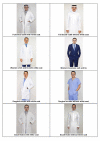The Effect of Male Physicians' Outfits on the General Population's Perception in Saudi Arabia
- PMID: 33489543
- PMCID: PMC7813537
- DOI: 10.7759/cureus.12131
The Effect of Male Physicians' Outfits on the General Population's Perception in Saudi Arabia
Abstract
Overview Successful medical care depends on the trust developed between a physician and his patient. Professionally dressed doctors are likely to achieve a higher level of trust from their patients than those with a non-professional appearance.For many years, the physician's famous white coat has been the standard professional wear around the world. Few studies in Saudi Arabia have been conducted to analyze what kind of physician outfits patients prefer and whether the choice of attire affects the patient's level of trust. These studies were either done in a single health institute, or in few primary healthcare clinics in one city. This study aims to analyze whether the type of clothing worn by a physician improves the level of trust between a patient and a doctor. Participants were asked about different styles of clothing, including Western business attire, traditional Saudi outfits, and surgical scrubs, and whether wearing the white coat was preferred. Moreover, we sought to establish if differences in age, gender, nationality, or educational background affected the responses. Methods This cross-sectional study was carried out in August and September 2018. Participants living in Saudi Arabia anonymously filled out an electronic questionnaire, distributed by social media, which measured the effect of male physicians' outfits on the general population's perception in Saudi Arabia. Participants were shown photographs of possible dress styles for physicians. Data were collected on the participants' demographics, their most and least preferred doctor's outfits, and the effect of the physician's attire on their level of trust. Results A total of 8231 participants were included in the survey: 53% males, 87.9% with university-level education or higher, and 93.5% of Saudi nationality; 76.1% of the participants responded "yes" saying that the outfit would have an effect on how a patient might receive medical advice and follow the doctor's recommendations. The most preferred outfits chosen by the participants were surgical scrubs with a white coat (39.3%), followed by a Western shirt and tie with a white coat (30.3%). The least preferred outfit was the full (traditional) Saudi outfit with a white coat (25.4%), followed by a Western business suit without a white coat (23.2%). The choices of most and least preferred attire were found to be impacted by different demographic factors, such as age, gender, and nationality, but not the educational background. Conclusion Physicians practicing in Saudi Arabia should note that their attire will earn the patient's trust and encourage compliance with advice or treatment. The most preferred outfits were surgical scrubs with a white coat and a Western shirt and tie worn with a white coat, whereas the least preferred ones were the traditional Saudi thobe, with and without shemagh or ghutra, and the Western business suit without a white coat.
Keywords: attire; dress code; physician; saudi arabia; traditional; western business suit; western tie; white coat.
Copyright © 2020, Basheikh et al.
Conflict of interest statement
The authors have declared that no competing interests exist.
Figures





Similar articles
-
Patients' attitudes toward the attire of male physicians: a single-center study in Saudi Arabia.Ann Saudi Med. 2014 Sep-Oct;34(5):383-9. doi: 10.5144/0256-4947.2014.383. Ann Saudi Med. 2014. PMID: 25827694 Free PMC article.
-
Patients' preferences for physicians' attire in Saudi Arabia.Saudi Med J. 2012 Jul;33(7):763-7. Saudi Med J. 2012. PMID: 22821311
-
Orthopaedic Physician Attire Influences Patient Perceptions in an Urban Inpatient Setting.Clin Orthop Relat Res. 2019 Sep;477(9):2048-2058. doi: 10.1097/CORR.0000000000000822. Clin Orthop Relat Res. 2019. PMID: 31294719 Free PMC article.
-
Children and Parent's Attitude and Preferences of Dentist's Attire in Pediatric Dental Practice.Int J Clin Pediatr Dent. 2015 May-Aug;8(2):102-7. doi: 10.5005/jp-journals-10005-1293. Epub 2015 Aug 11. Int J Clin Pediatr Dent. 2015. PMID: 26379376 Free PMC article. Review.
-
What's in a White Coat? The Changing Trends in Physician Attire and What it Means for Dermatology.Cutis. 2022 Jan;109(1):E20-E23. doi: 10.12788/cutis.0442. Cutis. 2022. PMID: 35180063 Review.
Cited by
-
Patient Trust in Primary Care Physicians: A Mixed Methods Study of Persons with Diabetes at University- Based Clinics in the Eastern Province of Saudi Arabia.Patient Prefer Adherence. 2022 Dec 13;16:3241-3255. doi: 10.2147/PPA.S377500. eCollection 2022. Patient Prefer Adherence. 2022. PMID: 36536670 Free PMC article.
References
-
- What to wear today? Effect of doctor’s attire on the trust and confidence of patients. Rehman SU, Nietert PJ, Cope DW, Kilpatrick AO. Am J Med. 2005;118:1279–1286. - PubMed
-
- On the value of an old dress code in the new millennium. Brandt LJ. Arch Intern Med. 2003;163:1277–1281. - PubMed
-
- Attitudes regarding surgeons’ attire. Major K, Hayase Y, Balderrama D, Lefor AT. Am J Surg. 2005;190:103–106. - PubMed
LinkOut - more resources
Full Text Sources
Miscellaneous
